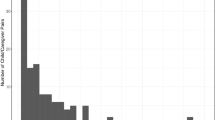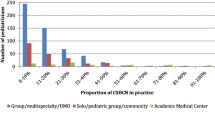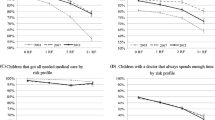Abstract
Objectives This study of primarily Latino caregivers and Latino child welfare-involved children had the following aims: (1) explore the return appointment adherence patterns at a pediatric medical clinic; and (2) determine the relationship of adherence to return appointments and caregiver, child, and clinic variables. Methods The sample consisted of caregivers of child welfare-involved children who were asked to make a pediatric outpatient clinic return appointment (N = 87). Predictors included caregiver demographics, child medical diagnoses and age, and clinic/convenience factors including distance from the clinic to caregiver’s home, days until the return appointment, reminder telephone call, Latino provider, and additional specialty appointment. Predictors were examined using χ2 and t tests of significance. Results Thirty-nine percent of all caregivers were nonadherent in returning for pediatric appointments. When return appointments were scheduled longer after the initial appointment, caregivers were less likely to bring children back for medical care. Conclusions The 39 % missed return appointment rate in this study is higher than other similar pediatric populations. Better coordination between pediatricians and caregivers in partnership with child welfare case workers is needed to ensure consistent follow-up regarding health problems, especially when appointments are not scheduled soon after the initial appointment.
Similar content being viewed by others
References
U.S. Department of Health and Human Services, Administration for Children and Families, Administration on Children, Youth and Families, Children’s Bureau (2013). Child maltreatment 2012. http://www.acf.hhs.gov/sites/default/files/cb/cm2012.pdf. Accessed August 17 2014.
Ringeisen, H., Casanueva, C., Urato, M., et al. (2008). Special health care needs among children in the child welfare system. Pediatrics, 122(1), e232–e241. doi:10.1542/peds.2007-3778.
Hansen, R. L., Mawjee, F. L., Barton, K., et al. (2004). Comparing the health status of low-income children in and out of foster care. Child Welfare., 83(4), 367.
Jee, S. H., Barth, R. P., Szilagyi, M. A., et al. (2006). Factors associated with chronic conditions among children in foster care. Journal of Health Care for the Poor and Underserved, 17(2), 328–341. doi:10.1353/hpu.2006.0062.
Horwitz, S. M., Chamberlain, P., Landsverk, J., et al. (2010). Improving the mental health of children in child welfare through the implementation of evidence-based parenting interventions. Administration and Policy in Mental Health and Mental Health Services Research, 37(1–2), 27–39. doi:10.1007/s10488-010-0274-3.
Schneiderman, J. U., Leslie, L. K., Arnold-Clark, J. S., et al. (2011). Pediatric health assessments of young children in child welfare by placement type. Child Abuse and Neglect, 35(1), 29–39. doi:10.1016/j.chiabu.2010.06.007.
Rubin, D. M., Alessandrini, E. A., Feudtner, C., et al. (2004). Placement changes and emergency department visits in the first year of foster care. Pediatrics, 114(3), e354–e360. doi:10.1542/peds.2003-0594-F.
Raghavan, R., Aarons, G. A., Roesch, S. C. et al. (2008). Longitudinal patterns of health insurance coverage among a national sample of children in the child welfare system. American Journal of Public Health, 98(3), 478–484. doi:10.2105/AJPH.2007.117408.
American Academy of Pediatrics. (2005). Fostering health: Health care for children and adolescents in foster care (2nd ed.). New York: American Academy of Pediatrics.
Leslie, L. K., Hurlburt, M. S., Landsverk, J., et al. (2003). Comprehensive assessments for children entering foster care: A national perspective. Pediatrics, 112(1), 134–142.
Kortenkamp, K. M., & Ehrle, J. (2002). The well-being of children involved with the child welfare system: A national overview (Series B, No. B-43). Retrieved from the Urban Institute http://files.ed.gov/fulltext/ED462504.pdf. Accessed 27 Oct 2015.
Davidson-Arad, B. (2005). Fifteen-month follow-up of children at risk: Comparison of the quality of life of children removed from home and children remaining at home. Children and Youth Services Review, 27(1), 1–20. doi:10.1016/j.childyouth.2004.07.002.
Child Welfare League of America. (2007). CWLA standards of excellence for health care services for children in out-of-home care. Washington D.C.: Child Welfare League of America.
Celano, M. P., Linzer, J. F., Demi, A., et al. (2010). Treatment adherence among low-income, African-American children with persistant asthma. Journal of Asthma, 47(3), 317–322. doi:10.3109/02770900903580850.
Yang, S., Zarr, R. L., Kass-Hout, T. A., et al. (2006). Transportation barriers to accessing health care for urban children. Journal of Health Care for the Poor and Underserved, 17(4), 928–943. doi:10.1353/hpu.2006.0137.
Specht, E. M., Powell, K. R., & Dormo, C. A. (2004). Factors affecting missed appointment rates for pediatric patients insured by Medicaid in a traditional hospital-based resident clinic and hospital-owned practice settings. Clinical Pediatrics, 43(8), 749–752. doi:10.1177/000992280404300810.
Flores, G. (2000). Culture and the patient-physician relationship: Achieving cultural competency in health care. The Journal of pediatrics., 136(1), 14–23.
McPherson, M. L., Lairson, D. R., Smith, E. B., et al. (2002), Noncompliance with medical follow-up after pediatric intensive care. Pediatrics, 109(6):e94. doi:10.1542/peds.109.6.e94.
Schneiderman, J. U., Smith, C., & Palinkas, L. A. (2012). The caregiver as gatekeeper for accessing health care for children in foster care: A qualitative study of kinship and unrelated caregivers. Children and Youth Services Review, 34(10), 2123–2130. doi:10.1016/j.childyouth.2012.07.009.
Schoetzau, A., Gehring, U., Franke, K., et al. (2002). Maternal compliance with nutritional recommendations in an allergy preventive programme. Archives of Disease in Childhood, 86(3), 180–184.
Pesata, V., Pallija, G., & Webb, A. A. (1999). A descriptive study of missed appointments: Families’ perceptions of barriers to care. Journal of Pediatric Health Care., 13(4), 178–182. doi:10.1016/S0891-5245(99)90037-8.
Sanders, L. M., Thompson, V. T., & Wilkinson, J. D. (2007). Caregiver health literacy and the use of child health services. Pediatrics, 119(1), e86–e92. doi:10.1542/peds.2005-1738.
Rust, C. T., Gallups, N. H., Clark, W. S., et al. (1995). Patient appointment failures in pediatric resident continuity clinics. Archives of Pediatrics and Adolescent Medicine, 149(6), 693. doi:10.1001/archpedi.1995.02170190103018.
Hamilton, W., Round, A., & Sharp, D. (2002). Patient, hospital, and general practitioner characteristics associated with nonattendance: A cohort study. British Journal of General Practice, 52(477), 317–319.
Downs, S. W., Moore, E., McFadden, E. J., et al. (2008). Child welfare and family services: Policies and practice (8th ed.). Boston, MA: Pearson Education.
Andrews, R., Morgan, J., Addy, D., et al. (1990). Understanding non-attendance in outpatient paediatric clinics. Archives of Disease in Childhood, 65(2), 192–195. doi:10.1136/adc.65.2.192.
Celano, M. P., Phillips, K. M., & Ziman, R. (1998). Treatment adherence among low-income children with asthma. Journal of Pediatric Psychology, 23(6), 345–349. doi:10.1093/jpepsy/23.6.345.
Dawson, K., & Berry, M. (2001). Engaging families in child welfare services: An evidence-based approach to best practice. Child Welfare, 81(2), 293–317.
Glisson, C., & Green, P. (2011). Organizational climate, services, and outcomes in child welfare systems. Child Abuse and Neglect, 35(8), 582–591.
Chipungu, S. S., & Bent-Goodley, T. B. (2004). Meeting the challenges of contemporary foster care. Future of Children, 14(1), 75–93.
Cameron, E., Heath, G., Redwood, S. et al. (2013). Health care professionals’ views of paediatric outpatient non-attendance: Implications for general practice. Family Practice, cmt063. doi:10.1093/fampra/cmt063.
Sawyer, S., Zalan, A., & Bond, L. (2002). Telephone reminders improve adolescent clinic attendance: A randomized controlled trial. Journal of Paediatrics and Child Health, 38(1), 79–83. doi:10.1046/j.1440-1754.2002.00766.x.
Institute of Medicine of the National Academies. (2015). Transforming health care scheduling and access: Key findings and recommendations. http://iom.nationalacademies.org/~/media/Files/Report%20Files/WaitTimesKeyFindingsRecs.pdf. Accessed July 13, 2015.
Acknowledgments
The authors want to acknowledge two grants that supported this research: National Institute of Health: The Eunice Kennedy Shriver National Institute of Child Health & Human Development K01-HD05798 (PI: Schneiderman) and the University of Southern California School of Social Work, Behavioral Health Research Cluster Grant. The content is solely the responsibility of the authors and does not necessarily represent the official views of National Institutes of Health or the Eunice Kennedy Shriver National Institute of Child Health & Human Development. We would also like to acknowledge the Kellerman College Merit Fellowship (Smith).
Author information
Authors and Affiliations
Corresponding author
Ethics declarations
Conflict of interest
None.
Rights and permissions
About this article
Cite this article
Schneiderman, J.U., Smith, C., Arnold-Clark, J.S. et al. Pediatric Return Appointment Adherence for Child Welfare-Involved Children in Los Angeles California. Matern Child Health J 20, 477–483 (2016). https://doi.org/10.1007/s10995-015-1845-4
Published:
Issue Date:
DOI: https://doi.org/10.1007/s10995-015-1845-4




